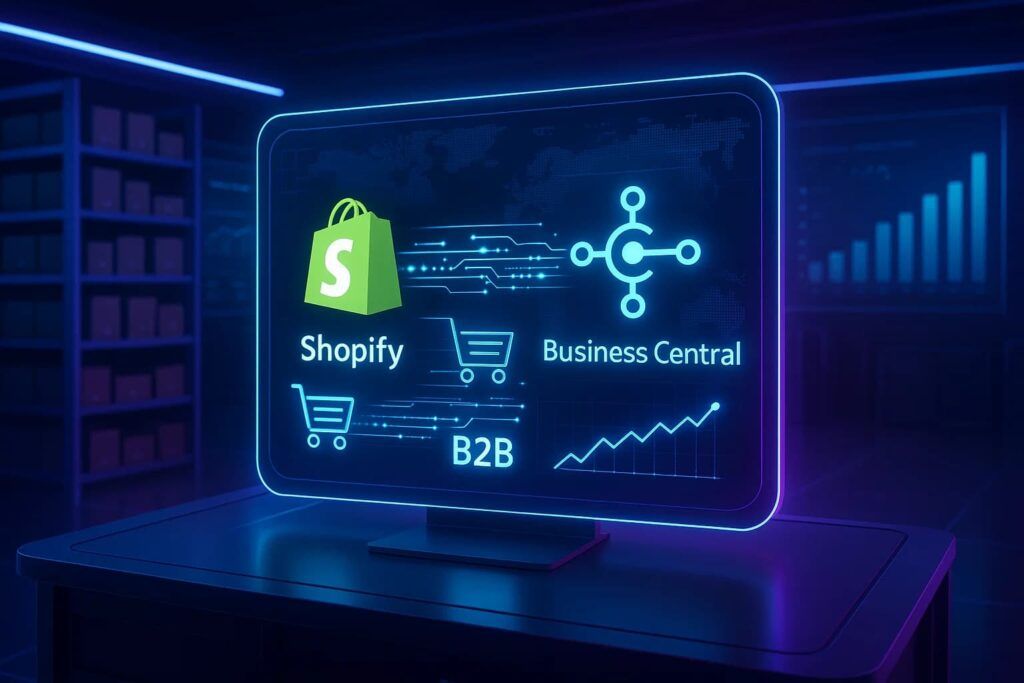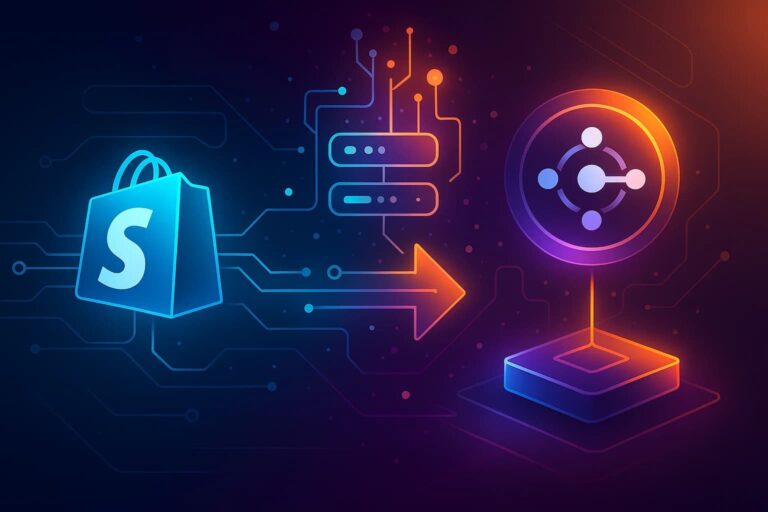Is your business thriving with a dynamic duo of Shopify and Microsoft Dynamics 365 Business Central? That’s fantastic! This combination offers powerful e-commerce capabilities alongside efficient ERP management. But when it comes to integration, relying solely on Microsoft’s default Shopify Connector, you might be leaving money on the table and heading for trouble.
While this connector is suitable for simple Direct-to-Consumer (DTC) workflows, it often falls short for the complex demands of scaling businesses or those with wholesale (B2B) operations. In fact, many users report it frequently breaks and requires constant reinstallation due to Business Central or Shopify updates, making it an unreliable solution for serious commercial ventures.
In this article, we’ll dive into 7 critical limitations of the default connector that prevent it from supporting scalable workflows, and discuss why a specialized integration solution is essential for your growth.

1. What Exactly is Shopify Business Central Integration?
Shopify Business Central integration connects your Shopify store (whether standard or Plus) directly to your Microsoft Dynamics 365 Business Central ERP system. The primary goal is to create a seamless flow of critical business data between the two platforms.
This means:
- Automating order processing.
- Keeping inventory accurate across both platforms.
- Synchronizing pricing and customer information.
- Efficiently managing payment terms (if applicable).
- Providing real-time product availability to your buyers.
This integration is vital for manufacturers, wholesalers, distributors, and any business with complex operational processes, managing purchase orders (POs), extending credit terms, or serving a diverse customer base.
2. 7 Major Limitations of the Default Shopify Connector
The built-in Shopify Connector offers basic synchronization, but it quickly becomes a bottleneck for advanced Shopify Business Central integration needs. Here are its significant drawbacks:
2.1. No True Two-Way Customer/Company Sync
The default connector can pull new customer records from Shopify into Business Central, but pushing updates from Business Central back to Shopify is often limited or incomplete. If a customer’s contact information, billing address, or company structure changes within your ERP, those crucial updates might not automatically reflect in Shopify.
- Business Impact: This leads to disconnected data, requiring tedious manual updates, increasing the risk of errors, and frustrating your customers with outdated information.
2.2. Catalogs and Pricing Aren’t Fully Integrated
Shopify can manage various product catalogs and pricing structures. Business Central handles price groups and customer-specific pricing. However, the default connector often fails to effectively map complex pricing configurations from BC to Shopify’s advanced catalog and pricing features (e.g., tiered or quantity-based custom pricing).
- Business Impact: Without this critical link, your customers might see generic product listings or incorrect prices, negating the personalization benefits and leading to missed sales opportunities.
2.3. Contact Roles Are Lost During Synchronization
In Shopify (especially Shopify Plus), a company can have multiple contacts with distinct roles (e.g., Buyer, Finance, Administrator). The default connector typically only syncs the primary contact, ignoring the specific roles of other vital personnel.
- Business Impact: This undermines essential workflows such as approval routing for purchase orders, segmented invoicing, or granting role-based access to specific Shopify features. Your internal teams lose valuable context, hindering efficient customer management.
2.4. Orders Lack Crucial Contextual Data
While the connector moves sales orders from Shopify to Business Central, it often lacks vital context. Information such as the specific company name, the buyer’s role, the custom catalog used, or the associated PO number often doesn’t transfer into usable fields. This also extends to issues like incorrect tax/VAT amounts and missing multi-currency details for non-USD orders.
- Business Impact: Incomplete order data makes robust reporting impossible, complicates dispute resolution, and severely limits your ability to automate crucial order fulfillment and invoicing processes.
2.5. Inflexible Order Logic and Processing
Unlike the diverse needs of modern businesses, the default connector treats all orders uniformly. It lacks the ability to handle:
- Holding PO-based orders for manual review or approval workflows.
- Applying custom processing rules for specific tagged accounts (e.g., VIP customers).
- Routing orders differently based on region, shipping method, or payment terms.
- Business Impact: This rigidity forces manual intervention for complex orders, slows down fulfillment, and introduces significant inefficiencies that don’t scale as your business grows.
2.6. Limited Sync Filtering and Tag-Based Logic
While Microsoft has made minor improvements to filtering capabilities (e.g., by ship-to country or tax amount), the default connector still offers minimal control over what data syncs. You cannot choose to:
- Synchronize only specific customer segments.
- Import orders based on custom tags (e.g., “Wholesale,” “International”).
- Route data differently based on Shopify Market or Company Segment.
- Business Impact: This lack of granular control often means you’re syncing irrelevant data or performing manual workarounds, leading to cluttered ERP data and reduced operational control. It also contributes to slow sync performance, which can cause critical issues like oversells or stockouts.
2.7. No Comprehensive Audit Trail or Custom Logging
The connector provides only basic synchronization logs, which are often insufficient for detailed operational oversight. While Microsoft has improved log display, you likely won’t find tailored insights such as:
- Which specific contact from a company placed an order.
- What custom catalog or price list was applied to a particular transaction.
- Which payment terms were selected for an order.
- Detailed reasons for sync failures, such as address character limits (where Shopify addresses over 50 characters on the first line can cause sync failure in BC).
- Business Impact: Without this deep visibility, troubleshooting becomes a nightmare, compliance requirements are harder to meet, and supporting your customers as you scale becomes increasingly challenging.
3. What’s the Alternative for Robust Shopify Business Central Integration?
For businesses serious about achieving true Shopify Business Central integration and avoiding the pitfalls of the default connector, the answer lies in adopting flexible, purpose-built integration platforms. These solutions are designed to handle the complexities of e-commerce, whether you’re running a B2B operation or a large-scale DTC business.
Consider a platform like HexaSync (or other specialized third-party solutions such as Celigo, Patchworks), which offers advanced capabilities tailored for complex scenarios:
| Capability | Default Connector | HexaSync/Specialized Solution |
|---|---|---|
| True Bi-directional Customer/Company Sync | ❌ | ✅ |
| Catalog-to-Price Group Mapping | ❌ | ✅ |
| Multiple Contacts Per Company | ❌ | ✅ |
| PO-Based Workflows | ❌ | ✅ |
| Custom Order Routing | ❌ | ✅ |
| Tag-Based Sync Filters | ❌ (Limited) | ✅ |
| Visual Logs & Retries | ❌ (Improved) | ✅ |
| Handles Complex Tax/Currency | ❌ | ✅ |
| Supports All Product Variants | ❌ | ✅ |
Robust platforms like HexaSync help you unlock true integration potential without extensive custom coding. They deliver the automation, accuracy, and scalability that modern businesses demand.
4. Conclusion: Don’t Let Your Integration Hold You Back
If your business relies on seamless Shopify Business Central integration, Microsoft’s Shopify Connector simply won’t cut it for scalable operations. It’s built for simplicity, not complexity.
To drive efficiency and growth in the competitive market, you need an integration solution that supports:
- Advanced custom catalogs and pricing.
- Comprehensive customer-level data handling and two-way sync.
- Sophisticated order logic automation.
- Role-based contact synchronization.
- Detailed logging and robust error handling.
Investing in a specialized integration platform means you can reduce manual effort, eliminate data discrepancies, improve customer satisfaction, and focus on what truly matters: growing your business efficiently.
Sources:
- [1.1] Microsoft Learn: Shopify Connector Overview (General features & updates)
- [1.2] Microsoft Learn: Troubleshoot Shopify and Business Central integration (Logging & error resolution info)
- [2.1] Shopify Help Center: B2B on Shopify features (Shopify’s B2B features)
- [2.2] Shopify Help Center: Integrating external systems to B2B on Shopify (Shopify’s warnings on B2B compatibility with external integrations)
- [3.1] APPSeCONNECT Blog: Shopify Business Central Connector Limitations (Third-party analysis of limitations and real-world issues)
- [3.2] Dynamics Community Forums: Shopify Company Sync Error, Address Character Limit (Discussion on address sync errors)
